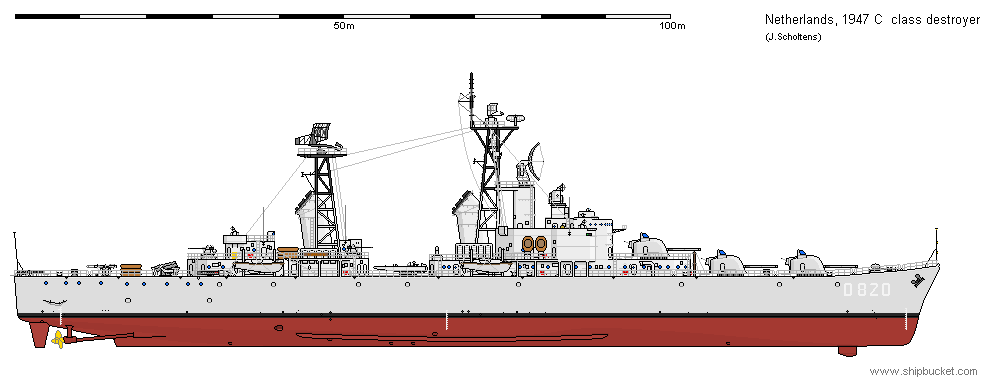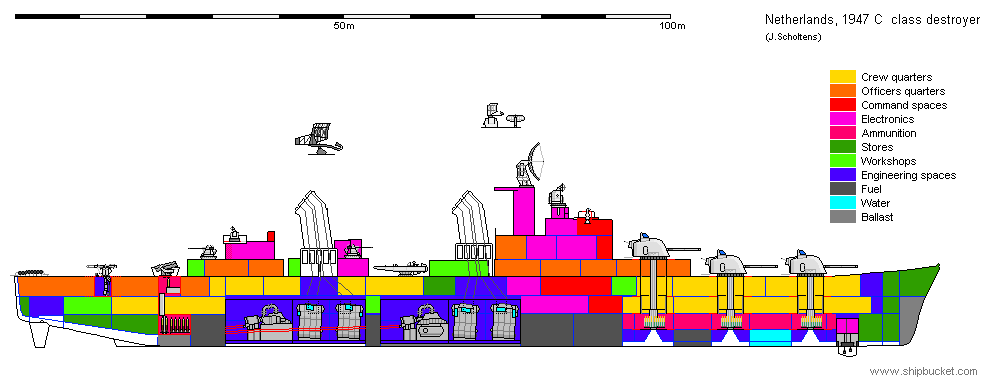Difference between revisions of "DDL 1947C class"
Acelanceloet (talk | contribs) |
Acelanceloet (talk | contribs) |
||
| (One intermediate revision by the same user not shown) | |||
| Line 1: | Line 1: | ||
| + | === History === | ||
In 1945, after the German occupation forces left the Netherlands, the 2 Eendracht class cruisers under construction in Rotterdam were heavily damaged by explosives set off by the leaving Germans. The yard machinery and cranes were destroyed as well. The Royal Netherlands Navy required flagships for their fleet, as the goal was to operate independently from allied navies in protecting the Dutch interests and their merchant fleet. While it was assessed if the cruisers could be repaired and completed, development started on the 1947 onderzeebootjagers (destroyers) which would form the main part of the new modern Dutch fleet. These classes, 4 (1947A) Holland class and 8 (1947B/1949) Friesland class were approved in 1948 and 1949 respectively, with them being constructed from 1950 to 1955 and from 1951 to 1958. After different studies were done on the feasibility of repairing the cruisers or building new ships, it was decided to build 3 new destroyers and scrap the cruisers. The construction of these destroyers was to be done by the traditional cruiser yards, RDM and Wilton Feijnenoord, both in Rotterdam, lying across the river from each other in Rotterdam. These 1947 C destroyers were approved in 1951, construction started in 1954. The last 1947 C destroyer was completed in 1958. | In 1945, after the German occupation forces left the Netherlands, the 2 Eendracht class cruisers under construction in Rotterdam were heavily damaged by explosives set off by the leaving Germans. The yard machinery and cranes were destroyed as well. The Royal Netherlands Navy required flagships for their fleet, as the goal was to operate independently from allied navies in protecting the Dutch interests and their merchant fleet. While it was assessed if the cruisers could be repaired and completed, development started on the 1947 onderzeebootjagers (destroyers) which would form the main part of the new modern Dutch fleet. These classes, 4 (1947A) Holland class and 8 (1947B/1949) Friesland class were approved in 1948 and 1949 respectively, with them being constructed from 1950 to 1955 and from 1951 to 1958. After different studies were done on the feasibility of repairing the cruisers or building new ships, it was decided to build 3 new destroyers and scrap the cruisers. The construction of these destroyers was to be done by the traditional cruiser yards, RDM and Wilton Feijnenoord, both in Rotterdam, lying across the river from each other in Rotterdam. These 1947 C destroyers were approved in 1951, construction started in 1954. The last 1947 C destroyer was completed in 1958. | ||
| Line 6: | Line 7: | ||
[[File:PD 1947C jager internals.png]] | [[File:PD 1947C jager internals.png]] | ||
------- | ------- | ||
| − | + | === Specifications: === | |
| + | * Length: 141m OA, 137m WL | ||
| + | * Beam: 12,5m | ||
| + | * Draft: 4,72m | ||
| + | * Displacement: 4300 metric tons | ||
| + | * Top speed: 33 knots on 60000 shp | ||
| + | * Machinery installation based on that of the Friesland class, which in turn was based on that of the Gearing class. | ||
| + | |||
| + | === Armament === | ||
| + | * 3 [[120mm/50 Bofors M1950]] | ||
| + | * 4 Bofors 40mm single #6 mountings | ||
| + | * 2 Bofors Depth Charge rocket launchers | ||
| + | * 1 Bofors Lichtraketwerper | ||
| + | * 1 Quintuple 21in torpedo launcher. | ||
| + | * 1 Depth charge rack. | ||
| + | |||
| + | === Fire control === | ||
| + | * HSA STARIK | ||
| + | |||
| + | === Radars: === | ||
| + | * [[HSA LW-01]] air search radar | ||
| + | * [[HSA VI-01]] heightfinding radar | ||
| + | * [[HSA DA-01]] Target indication radar | ||
| + | * [[HSA ZW-01]] Surface search radar | ||
| + | |||
------- | ------- | ||
| − | |||
| − | |||
[[Category:Early Cold War Destroyer challenge]] | [[Category:Early Cold War Destroyer challenge]] | ||
| + | [[category:Personal Designs]] | ||
| + | [[category:J.Scholtens]] | ||
| + | [[Category:Destroyers]] | ||
| + | [[Category:Netherlands]] | ||
Latest revision as of 20:37, 18 September 2018
History
In 1945, after the German occupation forces left the Netherlands, the 2 Eendracht class cruisers under construction in Rotterdam were heavily damaged by explosives set off by the leaving Germans. The yard machinery and cranes were destroyed as well. The Royal Netherlands Navy required flagships for their fleet, as the goal was to operate independently from allied navies in protecting the Dutch interests and their merchant fleet. While it was assessed if the cruisers could be repaired and completed, development started on the 1947 onderzeebootjagers (destroyers) which would form the main part of the new modern Dutch fleet. These classes, 4 (1947A) Holland class and 8 (1947B/1949) Friesland class were approved in 1948 and 1949 respectively, with them being constructed from 1950 to 1955 and from 1951 to 1958. After different studies were done on the feasibility of repairing the cruisers or building new ships, it was decided to build 3 new destroyers and scrap the cruisers. The construction of these destroyers was to be done by the traditional cruiser yards, RDM and Wilton Feijnenoord, both in Rotterdam, lying across the river from each other in Rotterdam. These 1947 C destroyers were approved in 1951, construction started in 1954. The last 1947 C destroyer was completed in 1958.
At first these new destroyers were to be some sort of broad beam Friesland class, having an additional superstructure level forward and an heightfinder radar on the aft superstructure. This design would loose to much speed to be acceptable, and would prove to be extremely cramped even in the conceptual design phase. Instead, an all new design was created, using elements of the British Cruiser-Destroyer concepts, the Dutch cruiser studies and of course the 1947 destroyers. To keep training and development costs relatively low, it was required to use as much components of the other new RNLN ships as possible. The role of the new destroyer was that of flagship, with their armament focussed on surface targets. Their ASW and AAW armament was mainly meant for self defence. To allow as much concentrated firepower on the limited size hull (limited by the machinery, which was the same as used in the Friesland class) the main battery of 3 Bofors twin 120mm turrets was all placed forward. This created an unique warship which could force away all destroyer sized opponents, and could even make a stand against the feared Sverdlov cruisers. Against opponents where the guns would prove insufficient, a quintuple torpedo launcher was placed amidships, which was meant to be fitted with homing ASuW torpedoes.
Specifications:
- Length: 141m OA, 137m WL
- Beam: 12,5m
- Draft: 4,72m
- Displacement: 4300 metric tons
- Top speed: 33 knots on 60000 shp
- Machinery installation based on that of the Friesland class, which in turn was based on that of the Gearing class.
Armament
- 3 120mm/50 Bofors M1950
- 4 Bofors 40mm single #6 mountings
- 2 Bofors Depth Charge rocket launchers
- 1 Bofors Lichtraketwerper
- 1 Quintuple 21in torpedo launcher.
- 1 Depth charge rack.
Fire control
- HSA STARIK
Radars:
- HSA LW-01 air search radar
- HSA VI-01 heightfinding radar
- HSA DA-01 Target indication radar
- HSA ZW-01 Surface search radar

